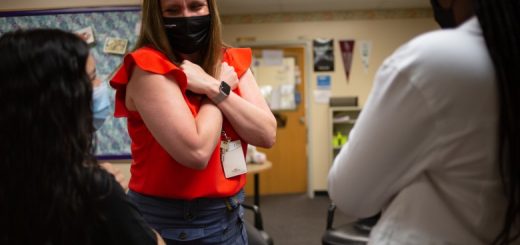Your Guide to an LGBT+ Inclusive Classroom
|
But PRIDE is about more
than romantic love. PRIDE is about self-love. PRIDE is for and about those -out or not- who are unapologetically and emphatically PROUD OF THEMSELVES -in a world that tried to deny themself pride- in a world that is still often so confused and afraid.
PRIDE is the courage to know- IT’S NOT YOU, BELOVEDS. IT’S THEM.
Their confusion is not yours. Their fear is not yours.
You -my beloveds- are PERFECT. |
This post brought tears to my eyes. In a world where people are put on the defensive for being who they are, Glennon encourages PRIDE where there has often been shame, fear, and loneliness.
Last year, I got to work on a course for Learners Edge using the book The Educator’s Guide to LGBT+ Inclusion, by Kryss Shane. While reading, I gained a deeper understanding of the LGBT+ community, inclusivity, and PRIDE. It is my hope that the sampling of information I’ve shared from the book below, will help you, too.
1. Terminology
4. In the Classroom and Direct Learning Spaces
5. Safety
6. Allyship
Terminology
Terminology can quickly become outdated. As we learn, grow, and change, so too do the terms we use. Below is terminology from The Educator’s Guide to LGBT+ Inclusion:
Gender Identity: Refers to a person’s internal sense of being male, female, somewhere in between, or somewhere completely outside of the gender binary.
Gender Expression: Relates to how a person chooses to communicate their gender identity.
Gay: A man who is romantically and sexually attracted to other males.
Lesbian: A woman whose romantic and sexual attraction is to other women.
Bisexual: A person who is sexually/romantically/emotionally attracted to both men and women, not necessarily simultaneously.
Transgender: A broad term meaning that a person’s gender identity does not match their assigned gender at birth.
Cisgender: A term to describe a person whose gender identity does match their assigned gender at birth.
Gender non-binary: A term to describe a person who identifies as a gender that is not male or female but may be a combination of the two or something different.
Gender fluid: A term to describe a person whose gender identity may change or evolve over time.
Agender: A term used to describe a person who does not identify as having a gender.
Assessing Your School
The author recommends a review of documents, flyers, emails, handbooks, hiring practices, staff trainings, orientations, and rules for inclusivity and to consider what the experience of school is like for those who identify as LGBT+.
Inclusive Curricula
Until the time when your school or district is updating materials, the author champions the importance of updating lessons with the goal of inclusivity. Below are some of her suggestions.
Math: Review word problems so they reflect a variety of people and consider gender neutral names. Be mindful of stereotypes about math.
Sciences: Be aware of biased research. Highlight the accomplishments of scientists from all races, genders and backgrounds.
Social Studies: Like Civil Rights and Women’s Rights consider how studies about LGBT+ like the laws and treatment of those who identify as LGBT+ could be included in the curriculum.
English: Provide stories from a variety of authors ensuring people with disabilities, people of color, and from a variety of family types are included.
World languages: Discuss the culture and politics in different parts of the world.
Physical Education: Allow children to wear comfortable clothing to school or make changing optional. Make sure all have a chance to participate in different ways.
Music: Be sure to recognize the contributions of a variety of artists and to focus on inclusivity.
In the Classroom and Direct Learning Spaces
What is the message of your learning space? Review your classroom or learning space to ensure it gives the message that everyone is welcome.
Safety
Currently, there are no mandates or federal protections against discrimination for those who identify as LGBT+. Individual states decide whether a person can be discriminated against if they identify as LGBT+.
Allyship
The number of LGBT+ hate crimes continues to grow. Consider how you would respond to protect a person being victimized based on their identity.
As we celebrate PRIDE, consider reading The Educator’s Guide to LGBT+ Inclusion. The information in the book can assist us all in becoming more aware, informed, and our schools more inclusive.
Resources
Shane, K. The Educator’s Guide to LGBT+ Inclusion: A Practical Resource for K-12 Teachers, Administrators, and School Support Staff. 2020. Jessica Kingsley Publishers.
Featured Course:
Creating Safe and Supportive Spaces for LGBT+ Youth
Course 5143 | 3-Credits | Gr. PK-12+
 As we grow, we learn not everyone experiences the world in the same way, and life can be challenging for people who have been historically marginalized like those in the Lesbian, Gay, Bisexual, Transgender, plus (LGBT+) community. In this course, educators will increase their understanding and awareness about strategies to support and champion students who identify as LGBT+. In addition, teachers will expand their knowledge about allyship, create scripts for difficult conversations, discover ways to manage a variety of scenarios, and increase the inclusivity of the learning environment. Explore the lived experiences of LGBT+ community and apply new understanding to ensure all students see themselves represented in the classroom, school, and community.
As we grow, we learn not everyone experiences the world in the same way, and life can be challenging for people who have been historically marginalized like those in the Lesbian, Gay, Bisexual, Transgender, plus (LGBT+) community. In this course, educators will increase their understanding and awareness about strategies to support and champion students who identify as LGBT+. In addition, teachers will expand their knowledge about allyship, create scripts for difficult conversations, discover ways to manage a variety of scenarios, and increase the inclusivity of the learning environment. Explore the lived experiences of LGBT+ community and apply new understanding to ensure all students see themselves represented in the classroom, school, and community.



